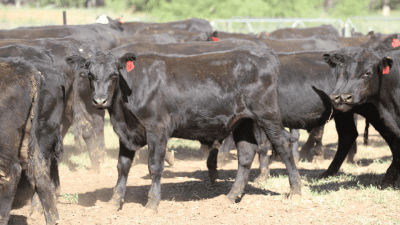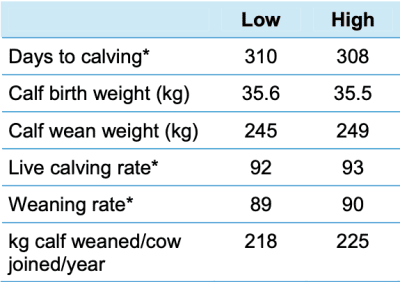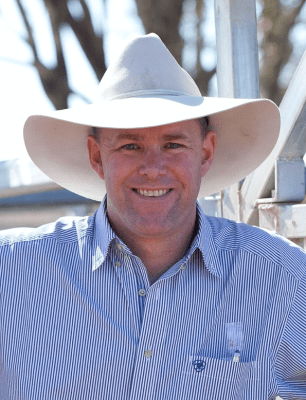Genetic selection goals should be firmly anchored in herd objectives that relate to productivity and profitability.
Across the range of traits commercial producers can consider, ultimately all enterprises are focused on the production of red meat. Without doubt the biggest driving factor for on-farm profitability is kilograms of beef produced per hectare.
 While there is a lot of opportunity for producers to drive production through their selection and management of herd fertility, its essential that red meat and muscling are not neglected either.
While there is a lot of opportunity for producers to drive production through their selection and management of herd fertility, its essential that red meat and muscling are not neglected either.
There are significant price differences offered to livestock possessing various levels of muscling. This has long been a focus of research work by the NSW Department of Primary Industries. Over the past 25 years, the NSW DPI has analysed the prices differences offered across all classes of cattle sold through markets reported on by the National Livestock Reporting Service, based on reported muscle scores.
Some of those differences over the years have been extraordinary.
The range of differences between steers of the same weight and fatness has been as much as 21c/kg liveweight. The NLRS reports are published on the MLA website, offering the opportunity to conduct similar market analysis for chosen centres or states across the classes of stock sold.
Looking back over the past year across sales in NSW and Qld, the price difference on offer for yearling steers in the range of 280-400kg has the average difference in muscle score (B to C, or C to D, for example) – averaging 67c/kg.
This far exceeds the expectations of many observers. Looking across the same time period and locations, the average difference for cows +520kg was 45c/kg between muscle scores.
These are not small differences. And while there has been some variation across the year, the trend to reward additional muscling has been consistent.
There are several reasons underpinning this trend, particularly associated with increased red meat yield. More importantly, this theme, which has existed for more than 25 years, shows no sign of changing.
Including muscling in genetic selection has a direct benefit for producers. As a trait, muscling is highly heritable. Producers who look to increase their muscle scores often see the results of these decisions earlier in their herd than for other lower heritable traits.
This in turn offers some more immediate financial return on the investment made in purchasing sires that exhibit a heavier muscle score.
It is important to recognise that as a selection trait, producers can improve their herd muscle score without necessarily compromising on other production traits, such as fertility or those traits associated with eating quality.
The long-running muscling selection project undertaken by NSW DPI demonstrated that selection for muscling did not restrict the ability of the higher-muscled cow herds to achieve production levels on par (or slightly better) than average or low-muscled cow herds.

Days to calving = days from start of joining to calf birth; Live calving rate = percentage of joined cows that produced a live calf; Weaning rate = percentage of cows joined that weaned a calf
The figures at left highlight the calving rates and maternal productivity of cows in the muscle herd lines over ten years of fair to good nutrition.
The NSW DPI research has application for producers wanting to shape their selection objectives to more closely align with traits that have demonstrated impact on productivity and profitability.
Given that increasing muscle score does not have a detrimental impact on traits such as Days to Calving, Birth Weights or kg calf weaned/cow joined, muscle scoring can be included in a selection decision that has been made on sires that meet a producer’s genetic expectations for these and other traits.
At the point of physical assessment, assuming sires that have been identified as genetically suitable for a program, should be considered on the basis of structure and temperament and then for the degree of muscle volume displayed.
Ideally, the sire of choice should be the one offering the higher levels of muscling. Using sires with higher muscle along with a focus on in herd selection of better-muscled heifers will lead to significant herd changes.
 Alastair Rayner is the Principal of RaynerAg, an agricultural advisory service based in NSW. RaynerAg is affiliated with BJA Stock & Station Agents. He regularly lists and sell cattle for clients as well attending bull sales to support client purchases. Alastair provides pre-sale selections and classifications for seedstock producers in NSW, Qld and Victoria. He can be contacted here or through his website www.raynerag.com.au
Alastair Rayner is the Principal of RaynerAg, an agricultural advisory service based in NSW. RaynerAg is affiliated with BJA Stock & Station Agents. He regularly lists and sell cattle for clients as well attending bull sales to support client purchases. Alastair provides pre-sale selections and classifications for seedstock producers in NSW, Qld and Victoria. He can be contacted here or through his website www.raynerag.com.au

As an industry perhaps we need to move towards developing an objective way of measuring the entire muscularity of a live animal rather than just one muscle (EMA) and stop using visual (subjective) muscle scoring of cattle. The higher dressing percentage of muscled cattle is an important consideration for profitability of finished cattle
Thanks for your comment, Matt. Meat science suggests the eye muscle is about the best indicator muscle of an animal’s overall meat yield. The correlations are quite high. However there is some interesting work happening in live animal scanning, using algorithms. And of course there is DEXA, and camera-based carcase yield assessment. Might be time for an update. Editor
I wonder, does the lower muscle score group in the NLRS data include a lot of Bos Indicus content cattle, which for various reasons may attract a lower c/kg? I’m not convinced that a heavily muscled (maybe Euro style) steer attracts more c/kg than a moderately muscled Angus steer from an above average IMF selection herd, targeted into the long fed market, for example? [Comparing c/kg as your article is, not going into a $/Ha comparison, which is of course more important]
Thanks for your comment, Sarah. The NLRS data is compiled across saleyards and the reporting doesn’t include breed as a descriptor. It is important to remember that muscle score is an assessment of the total volume of the beast, which is length, width and depth. While any bos indicus animal may have a more narrow stance and less width compared to some British or European breeds, they have the length and depth which allows them to perform well on muscle volume. The trends for muscle scores are consistent across cattle class. However in your example of a animal bred for a specific program such as a longfed program, the drivers of price may be more around marbling than on muscling.
Nice article Al – always a good read! The other point not to miss with increasing muscling is production efficiency. Putting down a kg of muscle takes 4 to 6 times less feed and energy than laying down a kg of fat. When we start calculating and trading carbon, more muscular cattle are going to shine brightly. The feed conversion ratio of more muscular animals is far lower than lighter muscled animals, which can only be celebrated in a world of limited resources and changing environments.